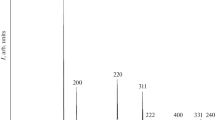Abstract
The heat capacity of eskolaite Cr2O3(c) was determined by adiabatic vacuum calorimetry at 11.99–355.83 K and by differential calorimetry at 320–480 K. Experimental data of the authors and data compiled from the literature were applied to calculate the heat capacity, entropy, and the enthalpy change of Cr2O3 within the temperature range of 0–1800 K. These functions have the following values at 298.15 K: C 0 p (298.15) = 121.5 ± 0.2 J K−1mol−1, S 0(298.15) = 80.95 ± 0.14 J K−1mol−1, and H 0(298.15)-H 0(0) = 15.30±0.02 kJ mol−1. Data were obtained on the transitions from the antiferromagnetic to paramagnetic states at 228–457 K; it was determined that this transition has the following parameters: Neel temperature T N = 307 K, Δ tr S = 6.11 ± 0.12 J K−1mol−1 and δ tr H = 1.87 ± 0.04 kJ mol−1.
Similar content being viewed by others
References
Minerals. A Reference Book. Vol. 2. Issue 2. Simple Oxides (Nauka, Moscow, 1965) [in Russian].
O. L. Kuskov, V. A. Kronrod, and H. Annersten, “Inferring Upper-Mantle Temperatures from Seismic and Geochemical Constraints: Implications for Kaapvaal Craton,” Earth Planet. Sci. Lett. 244, 133–154 (2006).
O. L. Kuskov and V. A. Kronrod, “Determining the Temperature of the Earth’s Continental Upper Mantle from Geochemical and Seismic Data,” Geochem. Int. 44, 232–248 (2006).
C. T. Anderson, “The Heat Capacities of Chromium, Chromic Oxide, Chromous Chloride and Chromic Chloride at Low Temperatures,” J. Am. Chem. Soc. 59, 488–491 (1937).
J. Volger, “Anomalous Specific Heat of Chromium Oxide (Cr2O3) at the Antiferromagnetic Curie Temperature,” Nature 170, 1027 (1952).
R. H. Bruce and D. S. Cannell, “Specific Heat of Cr2O3 near the Neel Temperatures,” Physical Review 15(9), 4451–4459.
S. Klemme, H. St. C. O’Neill, W. Schnelle, and E. Gmelin, “The Heat Capacity of MgCr2O4, FeCr2O4, and Cr2O3 at Low Temperatures and Derived Thermodynamic Properties,” Am. Mineral. 85, 1686–1693 (2000).
G. E. Moore and K. K. Kelly, “High-Temperature Heat Contents of the Chromium Carbides and Chromic Oxide,” U.S. Bur. Mines Rept. Inv. 662, (1944).
S. E. Ziemniak, L. M. Anovitz, R. A. Castelli, and W. D. Porter, “Thermodynamics of Cr2O3, FeCr2O4, ZnCr2O4, and CoCr2O4,” J. Chem. Thermodyn. 39 (11), 1474–1492 (2007).
M. Sh. Yagfarov, “New Method for the Measurement of Heat Capacity and Heat Effects,” Zh. Fiz. Khim. 43, 1620–1623 (1969).
A. G. Kabo and V. V. Diky, “Details of Calibration of Scanning Calorimeter of the Triple Heat Bridge Type,” Thermochim. Acta 347, 79–84 (2000).
V. V. Malyshev, G. A. Mil’ner, E. L. Sorkin, and V. F. Shibakin, “Automated Low-Temperature Calorimeter,” Prib. Tekh. Eksp., No. 6, 195–197 (1985).
V. M. Gurevich, O. L. Kuskov, K. S. Gavrichev, and A. V. Tyurin, “Heat Capacity and Thermodynamic Functions of Epsomite MgSO4 · 7H2O at 0–303 K,” Geokhimiya, No. 2, 97–100 (2007) [Geochem. Int. 45, 206–209 (2007)].
S. W. Kieffer, “Thermodynamics and Lattice Vibrations of Minerals: 3. Lattice Dynamics and an Approximation for Minerals with Application to Simple Substance and Framework,” Rev. Geophys. Sp. Phys. 17(1), 35–59 (1979).
V. M. Gurevich, K. S. Gavrichev, and V. E. Gorbunov, “Thermodynamic Properties of Cassiterite SnO2(c) at 0–1500 K,” Geokhimiya, No. 10, 1096–1105 (2004) [Geochem. Int. 42, 962–970 (2004)].
V. M. Gurevich, V. E. Gorbunov, K. S. Gavrichev, et al., “A Calorimeter for Heat Capacity Measurements from 50 to 300 K: The Heat Capacities of Kogarkoite Na3SO4F(c) at Low Temperatures,” Geokhimiya, No. 4, 423–434 (1999) [Geochem. Int. 37, 367–377 (1999)].
V. M. Gurevich and V. G. Khlyustov, “Calorimeter for Determining the Low-Temperature Heat Capacity of Minerals. Heat Capacity of Quartz at 9–300 K,” Geokhimiya, No. 6, 829–839 (1979).
V. M. Gurevich, K. S. Gavrichev, and V. E. Gorbunov, T. V. Danilova, and L. N. Golushina, “Low-Temperature Heat Capacity of Strontianite SrCO3(c),” Geokhimiya, No. 7, 744–751 (2001) [Geochem. Int. 39, 676–682 (2001)].
A. N. Kornilov and V. A. Sokolov, “Some Problems of Statistical Processing of Thermodynamic Data. II. Errors in Interpolation and Extrapolation of Non-Linear Function,” Zh. Fiz. Khim. 41(12), 3102–3107 (1967).
Author information
Authors and Affiliations
Corresponding author
Additional information
Original Russian Text © V.M. Gurevich, O.L. Kuskov, N.N. Smirnova, K.S. Gavrichev, A.V. Markin, 2009, published in Geokhimiya, 2009, No. 12, pp. 1249–1258.
Rights and permissions
About this article
Cite this article
Gurevich, V.M., Kuskov, O.L., Smirnova, N.N. et al. Thermodynamic functions of eskolaite Cr2O3(c) at 0–1800 K. Geochem. Int. 47, 1170–1179 (2009). https://doi.org/10.1134/S0016702909120027
Received:
Published:
Issue Date:
DOI: https://doi.org/10.1134/S0016702909120027



